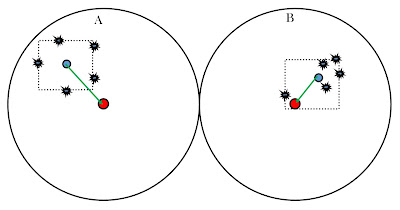Talk to someone who has just come from the range, and in the majority of cases the first thing you’ll hear is the “group size” he achieved, by which he means the extreme spread of a group of shots. The title of this article notwithstanding, group size does have some validity as a gauge of accuracy, but not a lot, especially taken by itself. In this article we will explore why group size is a relatively meaningless way to analyze a shot group and the things that really should be considered in addition to group size.
Consider the two hypothetical target pictures here. The starred black dots are the bullet hits, or “Points of Impact” (“POI”). The dashed black rectangle represents the extreme size of that group of shots—the “Group Size.” The red dot is the bullseye that the shooter was trying to hit, which we will call the “Intended Mean Point of Impact” (“IMPI”); in other words, he wanted his group of shots to be as close to that point as he could make them. The blue dot marks the actual center of the group of shots, or the “Mean Point of Impact” (“MPI”) of the group. The green arrow is the distance from the MPI to the IMPI.
Looking at the two targets, note that the black dashed rectangle is exactly the same size in both, which means that both groups have identical group sizes. Yet even a casual glance at the targets will show that the group shown on Target A is far worse than that on Target B; anyone can see that, even without the information in this article. Regardless, let’s go on an and analyze why B is better than A with an eye toward understanding how we should be gauging our shooting results.
In a perfect string of shots, all the POI would be exactly on the IMPI—in other words, every bullet would hit the bullseye directly and all the bullets would go through the same hole in the target. In reality, that almost never happens, so a more realistic way of stating the goal is that we want two things: First, we want the group to be as small as possible, and second, we want the center of the group of shots to be as close to the IMPI as possible. To do that, we have to have a way of determining the center of the group, which we defined above as the MPI. We can then simply measure the distance from the MPI to the IMPI.
One of the things that’s obvious when looking at the two targets is that Group A is much more spread out than is Group B. Although they have exactly the same group size, Group B’s shots are much more closely packed together, with only one sloppy shot and one flyer. Thus, it’s obvious that just knowing the group size tells us very little. A better gauge is to calculate the Mean Radial Deviation, which is defined as the average straight-line distance of each shot from the MPI. In the nineteenth century this was sometimes called the “Figure of Merit” (see link below).
The next thing that’s obvious about these targets is that the MPI of Group A is much farther from the IMPI than is the MPI of Group B—almost twice as far. That means that not only is Group A “sloppier” than Group B, it’s also less accurate.
From this, it should be obvious that three things need to be considered when judging a group of shots: First, the group size; second, how closely the shots are packed together; and third, how close the center of the group of shots is to the bullseye. So knowing the group size is fine, but it really tells us very little.
This article was intended as a discussion of why group size isn’t nearly as important as it is generally taken to be rather than a “how to” piece. To learn more about the Figure of Merit (mean radial deviation) and how to calculate it, including a link to a video demonstration of how to do it, see the article here: The Figure of Merit. Also, regular readers of this blog will probably be sick of reading about it by now, but the String Test is a faster, easier way to gauge all three factors discussed above in a single number; to learn more abut it, see the article here: The String Test.





No comments:
Post a Comment